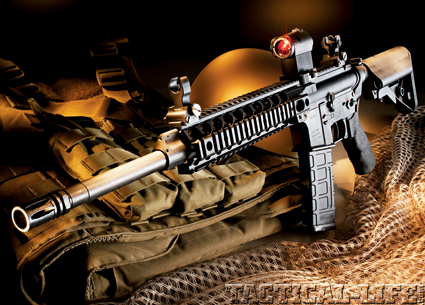Lewis Machine & Tool has developed a strong reputation for building solid rifles with many capabilities. This MRP Defender is no exception—it’s perfectly suited to any operation. Shown with an Aimpoint Micro H-1 red dot and Huldra folding backup sights.
The ability to change barrels on a combat rifle has been around a long time. They have been doing it on light machine guns and other belt-fed guns for years. In that case, it is about replacing them as they are burned up. Eventually, someone got around to trying to do it on an AR rifle. The operational need was geared towards our Special Forces operators and their need for a multi-purpose weapon. Their missions often require vastly different equipment. For some, a 20-inch barrel is fine; for others, a 14.5-inch barrel is too long. The mission may require a suppressor. What if operators need a larger caliber?
The AR platform really lends itself to the barrel-change idea, as the standard receiver pretty much holds the barrel in place. The barrel, chamber, and bolt all lock together and contain the pressure from the discharge, so the receiver does not need to be particularly strong. On a standard gun, it is a simple matter of threading the barrel on and lining up the gas tube. As long as all that stuff lines up and stays in place, you should be good to go.
Advertisement — Continue Reading Below
But the devil is in the details, and that is where most of the issues have come up. Some of these barrel-change systems have resulted in cracking receivers and iffy operation. Others are so complicated that an armorer is needed to complete the change. For the platform to really succeed, barrel changes need to be easy to perform—preferably by the operator—and the parts have to stay in place once it’s done. The trick was making it work for an operator in the field, and one of the first to do so successfully was Lewis Machine & Tool, with their MRP (Monolithic Rail Platform).
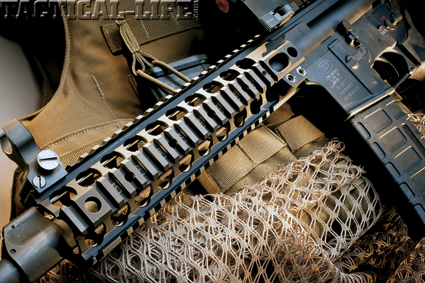
LMT’s one-piece Monolithic Rail Platform is incredibly strong. The forend allows the barrel to free-float, provides plenty of real estate for accessories, and has a narrow design so operators can install rail covers without it becoming too bulky.
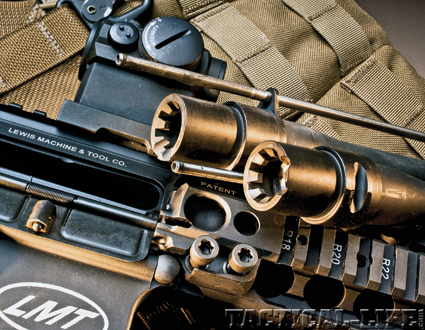
For versatility in the field, operators can quickly change the MRP’s barrels, from a 16-inch barrel to a shorter CQB barrel for example, with no change in point of impact or zero.
Advertisement — Continue Reading Below
First Time
I first used this system some ten years ago as a SWAT officer. Lewis Machine & Tool was well known at the time as one of the best built AR-platform rifles out there. All of their weapons and parts were truly mil-spec, making them rugged, versatile and reliable. At the time, they were quietly providing equipment to our most elite forces, as well as SWAT teams all over the country.
The MRP seemed like the perfect system for me at the time. The 6.8 SPC was firmly in my radar, and as the primary firearms sergeant for the department, a rifle program was in the works. The MRP provided the ability to use the same setup for CQB and patrol. We obtained a rifle with a 16-inch barrel and a second 10.5-inch CQB barrel for use with a suppressor. Although the conversion to 6.8 SPC never materialized, the two 5.56mm barrels were used for a couple of years mated to my M16A2 lower. Although the upper in its 16-inch configuration was eventually sold, the barrel stuck with me and came in handy for this test.
The MRP addresses two of the primary issues with these systems. The barrel change is easy and quick, yet secure. The other is the strength of the upper receiver. In order to make the change work easily, a free-floated barrel is really best. That presents other issues for those operators who stack the accessories deep on their rifles. Your typical Special Forces operator has optics, lights, lasers and everything needed to win that fight day or night. On a free-floated barrel, that puts all the weight of these devices where the forend and receiver mate, resulting in cracking and an occasional failure. By building the MRP from one piece of metal, that stress is alleviated. The monolithic design makes for a truly solid and stable system while allowing for fast and reliable barrel changes. Given its otherwise mil-spec design, it could drop on any M16 lower currently fielded making it about perfect for most operators.
Advertisement — Continue Reading Below
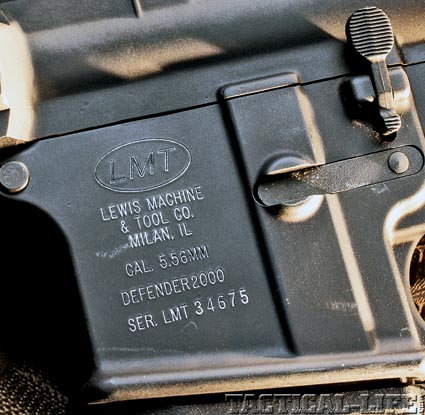
Built to military specifications, the Defender 2000 lower features sturdy, reliable components and operators will find the controls in all the usual places.
Gun Details
LMT provided a CQB MRP Defender Model 16 for testing. This rifle uses their CQB MRP Monolithic receiver/forend. The forend includes two flush-cup sling attachments on either side and one on the bottom.
The rails are all mil-spec, numbered, and completely SOPMOD compatible. The overall diameter is narrow, allowing for the addition of protective rails that do not make it overly large. Two Torx screws are used to attach the barrel. The rifle came with a set of LMT removable A2-type sights.
Advertisement — Continue Reading Below
The barrel is 16 inches long, chrome-lined and cryogenically treated with a 1-in-7-inch twist rate. The bolt carrier group is a standard semi-auto group with a standard charging handle. A torque wrench and driver are included to make certain the barrel tensioning screws are not over-tightened.
The upper is mated to a Defender 2000 lower receiver, which contains a mil-spec single-stage trigger that is crisp and solid. The rifle ships with one 30-round magazine, two heavy-duty push-button sling swivels, three rail panels and a tactical sling. The buttstock is an LMT SOPMOD model with battery compartments on either side.
Swapping out barrels on the MRP is really easy. Simply unscrew and remove the two screws and it pulls right out. It has the side benefit of making cleaning really easy. Swap the barrels and tighten the screws using the torque wrench. The manual calls for 140-inch-pounds of torque tightened front to back. The trick here is not to over-tighten them—you really do not need to crank them down. By using the same setting each time, it generally makes for little change in point of impact with a barrel change and your receiver will last forever.
Advertisement — Continue Reading Below
Accessories
Before testing the LMT Defender as supplied, I wanted to test the upper with my older LMT 10.5-inch CQB barrel. I also added my Mike’s Guns Jet suppressor for some CQB drills. My M16A2 lower was used for all the live-fire testing with the short barrel. It contains a Geissele SSF trigger group, along with all-new Colt internals. The bolt group employed is a Colt full-auto setup.
For all of the CQB testing, I attached an Aimpoint Micro H-1 using a LaRue quick-detach mount. The non-folding sights were replaced with a set of folders from Huldra. They are closely patterned after Troy BattleSights and have proven very solid on a few test rifles. When using a red dot, especially one as solid and reliable as the Aimpoint Micro H-1, my preference is to have the sights folded completely out of the way. For work in the shoot house, I mounted the new Insight WL1-AA light/laser combo. Finally, for accuracy testing, I mounted a Weaver 1-5X Tactical riflescope.
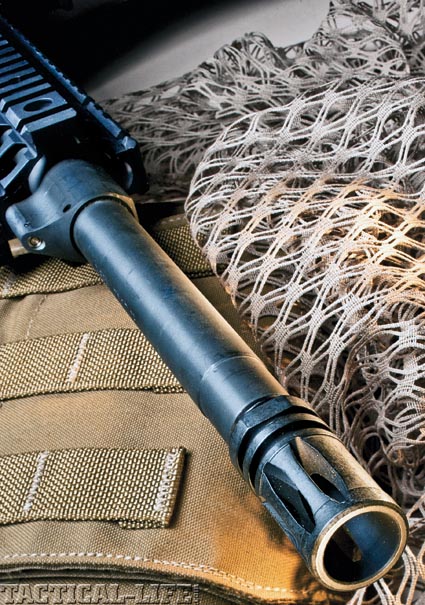
Although a simple A2 flash suppressor is mounted on the 16-inch barrel, it is threaded to accommodate a suppressor or other muzzle device, such as LMT’s Rebar Entry Attachment.
Advertisement — Continue Reading Below
Shooting Impressions
I tested this short-barrel weapon with and without the suppressor. The flash suppressor was a birdcage of some sort mounted on this barrel years ago. It worked fine but was typically loud, as you might expect with a short barrel. With the MGSS’ Jet suppressor added, this setup really rocked.
Mated to the Colt lower and Colt bolt carrier, this setup worked great. It had a couple hiccups on polymer-tipped bullets, but many of these do. On semi-auto, the cartridges worked pretty well; dialed up to select fire and a couple of failures to feed occurred due to the tip coming off. This is why many will simply not use these types of bullets in AR-type rifles. It fed all the FMJ or OTM bullets without issue, and showed a special preference for the Winchester 55-grain FMJ. From 25 yards and in, it pretty much cut an ever-growing hole in the target. It was very fast to access with the Aimpoint Micro H-1, and it was still pretty lightweight with the titanium suppressor attached.
Moving into the shoot house, the Insight light/laser combo allowed me to identify targets quickly and see the dot in the center of the light. It was very fast. All of this testing was done in full kit, and the SOPMOD stock worked perfectly with a set of rifle plates.
Advertisement — Continue Reading Below
Accuracy for all the CQB work both with the 10.5- and 16-inch barrels was excellent. The point of impact did not change—no matter how much each barrel heated up. Group shooting was equally impressive. My recollection with the first rifle tested years ago was that its accuracy was about as good as it gets. That proved to be the case this time around as well.
Group shooting was completed with the 16-inch barrel. Shots were fired from a prone position using a sandbag as a rest. For all the issues with tipped bullets on the 10.5-inch barrel, no such problems occurred with the 16-inch barrel. In fact, it was the Hornady 60-grain TAP that yielded the best group at just a fraction over an inch. Most of the rest printed between 1 and 1.5 inches. In this configuration, the MRP Defender Model 16 digested everything without any issues.
To complete the accuracy testing, I removed the barrel and reinserted it again before firing for groups again. This time, I pressed the trigger as quickly as the rifle could be placed back on target. This was done over 20 rounds, removing the barrel after each group of five rounds. All said and done, every round impacted inside 2 inches at 100 yards. There is no doubt that this rifle is plenty accurate, no matter its configuration or mission.
Advertisement — Continue Reading Below
Final Thoughts
Having used one so many years ago, it was nice to get a chance to test one of these rifles again. I really liked this setup then and still do. LMT now offers piston conversion kits for their MRP in both 12- and 16-inch version. They also offer a 16-inch conversion to 6.8 SPC, making the Defender even more versatile. If these work as well as this setup, there is little doubt that they are fantastic. LMT has long been quietly known for building excellent equipment for the professional and enthusiast alike, and that has certainly held true for this test. Since the barrel is still here, it may be time to see if I can round up a receiver to go with it!
